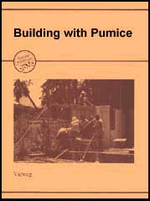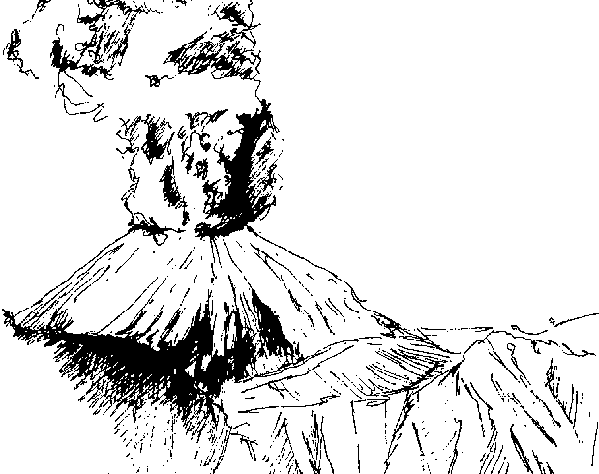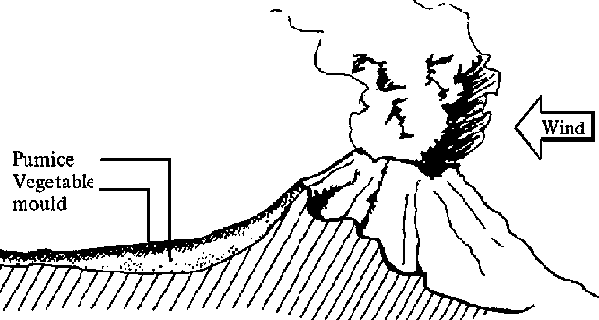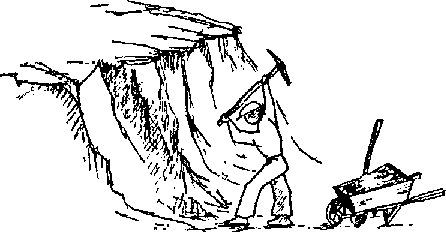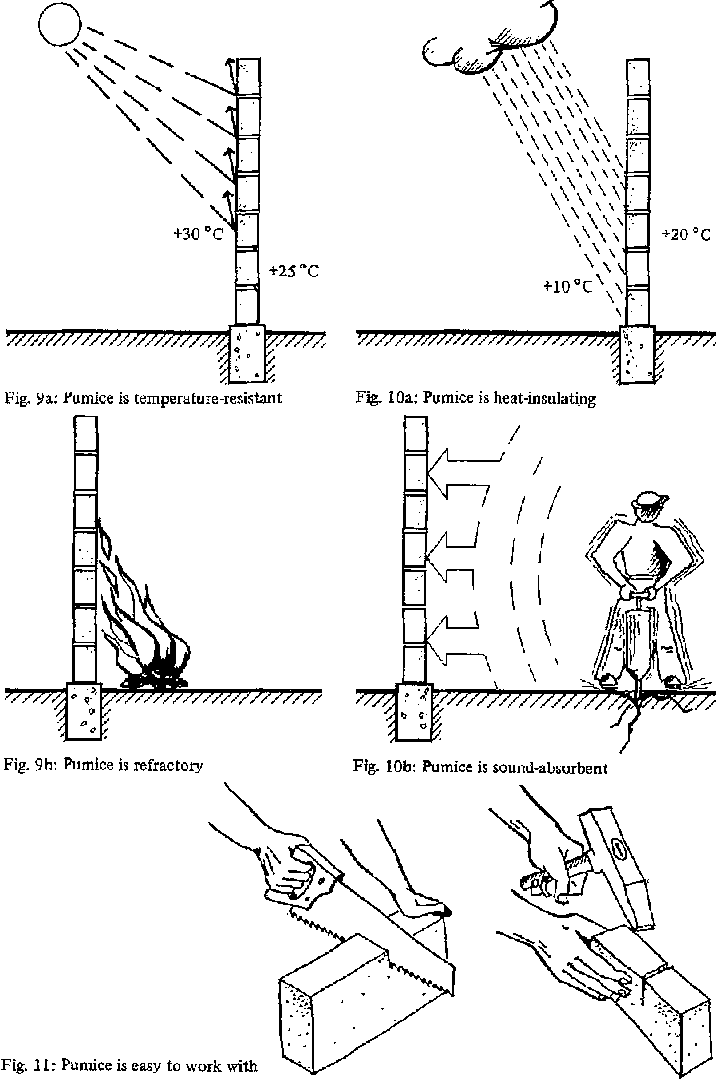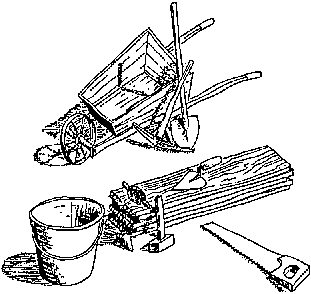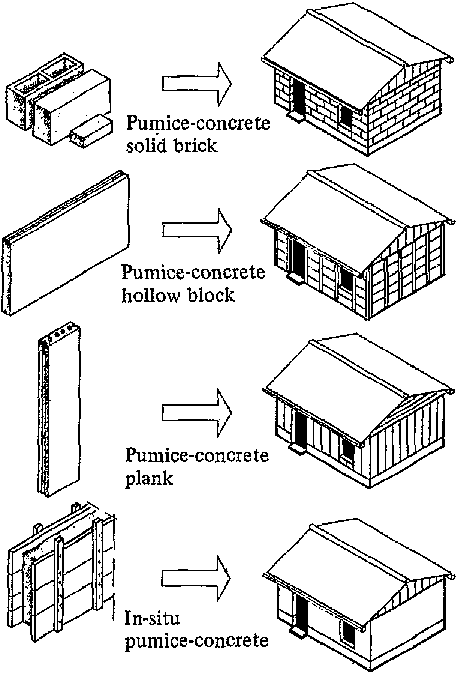This chapter outlines the options available for making building members from pumice. It provides information on where to find pumice and how to process it in a self-help situation.
What is Pumice?[edit | edit source]
Pumice is a very porous form of vitrified volcanic rock, usually of very light colon Its true density, i.e. the density of the powdered material, amounts to between 2 and 3 kg/ dm³ and its bulk density, i.e. the density of the loosely piled material, amounts to between 0.3 and 0.8 kg/dm3. In other words, pumice is very light. It has roughly the consistency of a mixture of gravel and sand, with light, porous individual granules that normally either float on water or sink only slowly. Pumice particles are either round or angular and measure up to 65 mm in diameter. Only particles in the 1 -16-mm size range should be used to obtain good building material.
Figure 5: A volcanic eruption
In addition to light-colored pumice, there are also various dark-colored forms referred to as lava, tuff, etc. They, too, can be used as building material, but the light-colored pumice processes better, as described in Chapter 2.4.
Pumice has the following chemical composition:
|
silica |
SiO2 |
approx. 55% |
|
alumina |
Al2O3 |
approx. 22% |
|
alkalies |
K2O+Na2O |
approx. 12% |
|
ferric oxide |
Fe2O3 |
approx. 3% |
|
lime |
CaO |
approx. 2% |
|
magnesia |
MgO |
approx. 1% |
|
titania |
TiO2 |
approx. 0.5% |
Pumice originates during volcanic eruptions, when molten endogenous rock is mixed with gases before being spewed out (Fig. 5). The light, spongy particles are hurled up and carried off by the wind. As they cool and fall back to earth, the particles accumulate to form pumice rock or boulders. Sometimes the molten rock is too heavy to be ejected, in which case it flows out and collects at the foot of the volcano as a compact, fairly homogeneous, usually somewhat less porous rock formation. Most such lava deposits can be cut up into natural stone blocks for direct use in construction work.
Where is Pumice Found?[edit | edit source]
Most pumice is found on the downwind side of volcanoes (Fig. 6).
Figure 6: Pumice deposits on the downwind side of a volcano
The average deposit is loose, with a layer thickness ranging from 50 to 300 cm. Pumice should always be extracted under expert supervision and not haphazardly; otherwise, the results will look like Figure 7. The thickness of the pumice strata decreases with increasing distance from the center of the eruption.
The size of pumice particles ranges from superfine powder (0-2 mm) to sand (2-8 mm) to gravel (8-65 mm). The particle porosity can reach 85%, meaning that 85% of the total volume consists of "air" and only 15% of solid material. Its high porosity gives pumice good thermal insulating properties and makes it very light.
Old pumice deposits in areas with once-active volcanoes are covered with a 0.2-1 m thick layer of humus. When quarrying it, care must be taken to ensure that no humus is mixed into the pumice. If a large area is being mined, e.g. for a housing project, the humus should be replaced afterwards to prevent erosion and consequent ecological damage.
Additional site-specific information on pumice deposits is available from the various national geological institutes and/or soil research offices.
What Properties Does Pumice Have?[edit | edit source]
Pumice has excellent properties. As a building material it is
Figure 8: Pumice extraction
- very light,
- inexpensive,
- refractory,
- resistant to pests,
- easy to work with,
- sound-absorbent,
- heat-insulating,
- temperature-balancing (Figs. 9, 10 and 11).
But then, it also has some negative properties like:
- the lower compressive strength of pumice concrete, as compared to concrete containing other, heavier aggregates;
- the tendency of its edges and corners to break off more easily than those of heavy concrete'
- its lack of frost resistance when wet.
Consequently, pumice building material should not be used for:
- foundations,
- components with constant exposure to water, e.g. in showers,
- components subject to heavy traffic, e.g. stair treads and floor tiles.
Figures 9, 10, 11
How Can Pumice Be Made into Building Members?[edit | edit source]
A few expedients that facilitate working with pumice are required for turning it into building members, e.g.:
- some means of hauling the pumice from the deposit to the building site (Fig. 12);
Figure 12: Various means of transportation
- various tools like a wheelbarrow, shovel, buckets, saw, hammer, nails, spirit level, a folding rule, trowel, plumb bob, set square, plastic sheeting, etc. (Fig. 13).
Figure 13: Various tools
- an adequate supply of natural pumice (amounting to, for example, about 5600 kg, or 7 m³ for a house with 30 m floor space). A wheelbarrow holds about 0.15 m³, meaning that about 45 wheelbarrow loads would be needed to build the house;
- wooden molds for bricks, molds, etc. and/ or a press for making cavity blocks (Fig. 14: cf. Figure 34, p. 31).
In addition, a roofed-over, level work area is needed. The pumice being processed should have a particle-size distribution of 1 - 16 mm. The requisite cement should be Portland cement with normal compressive strength, to which lime or pozzolana can be added. Pumice building members can also be made exclusively with lime, as described in Chapter 3. The cement and lime must be kept dry, and there should be enough on hand to last for a full week of work. The gauging water should be clean; unpolluted rainwater is well-suited. How to make the molds is described in Chapter 3.
In general, pumice building members are classified as lightweight concrete, since they are produced and processed in a similar manner, the main difference being that the aggregate -namely the natural pumice -is very light, porous and water-absorbent, so that such material has to be worked somewhat differently than normal-weight concrete.
As a rule, natural pumice is first saturated with water and then mixed with cement or lime, poured into the prepared molds, compacted (either manually or by mechanical means), removed from the mold and stored to set and cure.
What sets pumic material apart from normal-weight concrete is that pumice concrete is usually soil-moist, i.e. used with relatively little gauging water and only small amounts of fine-grain aggregate - enough to cover the pumice particles with cement paste, but not enough to fill the cavities between the particles of aggregate. Consequently, pumice building components normally have a porous not quite smooth surface like that of nor mar-weight concrete. If so desired or necessary, e.g. for facade tiles, fine aggregate like sand can be added to obtain a smooth surface.
What Kind of Buildings Can Be Made of Pumice?[edit | edit source]
Pumice-based material can be used for building various kinds of structures:
- single-story homes,
- apartment buildings (up to four stories),
- workshops and storehouses,
- schools.
This book deals with the construction of single-story homes, for which pumice building materiel can be made into (cf. Fig. 15):
Figure 15: What kind of buildings can be made?
- pumice concrete solid blocks (solid pumice bricks),
- pumice concrete cavity blocks,
- pumice tiles,
- pumice panels/planks,
- in-situ pumice concrete,
- special-purpose pumice building members (cf. Chapters 4.6 and 5).
Chapter 3 describes how prefabricated pumice wall members can be used for building houses.
Pumice-plank and pumice-panel homes are houses made of prefabricated members. After laying the foundation, the individual members (mainly the wall members) are prepared and used to erect the house on the foundation slab. This mode of construction is expecially well-suited for collective self-help measures in which several families wish to build the same kind of house, because erection of the plank or panel walls requires the work of several people at once (Fig. 16). One of the main advantages is the comparatively short erection time.
Pumice-concrete brick houses are built in a similar manner to heavy-clay brick houses, i.e. the masonry consisting of relatively small pumice bricks is built up on a solid foundation in the traditional manner. This method yields very individual homes and serves well for renovating or expanding existing homes.
